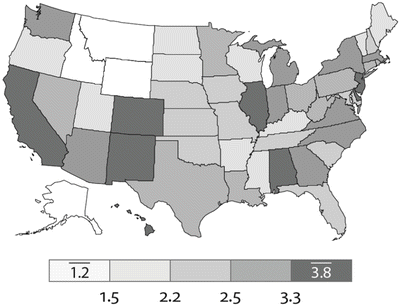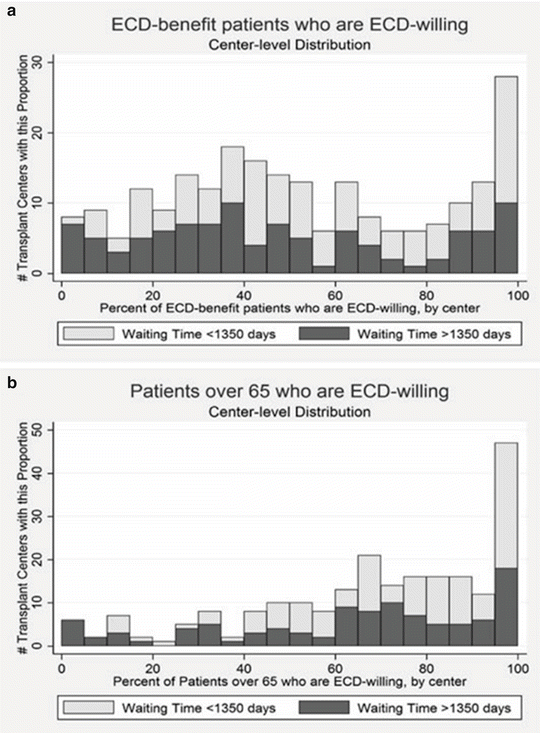Fig. 4.1
United Network for Organ Sharing national kidney wait list additions and composition by active status
Facts and Figures
Since UNOS began keeping records in 1987, over 500,000 organ transplants have been performed in the United States. More than 28,000 recipients receive lifesaving organ transplants each year. As of early June 2012, over 92,000 patients were registered with UNOS on the kidney transplant wait list. In 2011, 16,814 kidney transplants were performed, which included 11,043 from deceased donors (based on OPTN data as of May 25, 2012).
Wait Times
Because deceased donor kidney allocation is prioritized locally, the median wait time for kidney transplant varies across the country (Fig. 4.2) [1]. Efforts to equalize wait time across geographic regions have been met with both logistical and political resistance. The median wait time in 2009 was 2.3 years [1]. This varies by blood type, with blood groups O and B patients waiting the longest (5 and 6 years, respectively) compared to 1 and 3 years for blood types AB and A, respectively [2]. Wait time for Caucasians is about 40 % less than other races. Sensitized patients (i.e., patients who have anti-HLA antibodies as a result of blood transfusions, pregnancy, or prior transplants) may wait longer than patients who have low level of antibodies (PRA or panel reactive antibodies).


Fig. 4.2
Unadjusted median wait times in years for adults transplanted in 2009, by state of transplant center [1]
Kidney Allocation
Kidneys are allocated on a local, regional, and national level. When possible, kidneys are offered locally first to minimize organ preservation time, which is associated with better graft survival. The exception is sensitized recipients of zero human leukocyte antigen (HLA)-mismatched kidneys who are given priority to these close biological matches. Blood type, HLA matching, degree of sensitization, pediatric recipients, and time waiting on the list are factors taken into account in UNOS’ computer-based network for allocating donated organs. Every organ sharing institution is electronically linked via this secure, real-time environment over the internet so that donated organs can be placed as efficiently and as quickly as possible.
Point System for Kidney Allocation
The 1984 NOTA mandates that organ allocation take into account both efficiency (graft and patient survival) and equity (fair distribution) [3]. The allocation system was designed to balance fairness with medical utility and improved organ survival. Potential recipients receive one point for each year they wait on the list. A few regions that have an approved variance in allocation define wait time as the time since initiating dialysis. Extra points are awarded to patients who are broadly sensitized (more than 80 % panel reactive antibody level and a negative crossmatch) and to pediatric patients. The system also includes points for better HLA-DR-matched recipients to promote longer graft survival, thereby promoting improved organ utility.
Listing Practices
Potential recipients undergo an evaluation to determine their candidacy for kidney transplantation and once listed, they may be required to undergo periodic testing. The evaluation process strives to identify patients who may benefit the most from transplantation, separating them from patients who may be placed at risk. Policies may vary between transplant centers within a region and across the country. Listing practices take into account median wait times and allocation variances within the region, as well as list size, while optimizing resource utilization. Some centers perform an intensive evaluation up front, which may delay time to listing. Others prefer to list with minimal or no workup and complete the evaluation later. For example, cardiac workup for low- or moderate-risk candidates at initial listing may not be required in an OPO with lengthy median wait times. However, this depends on predictability within the OPO and does not take into account zero antigen mismatch offers.
Acceptance Criteria
Acceptance criteria at a given transplant center will vary based on a number of factors and are often subjective. The risk tolerance of the transplant center and clinicians is an important factor here. This is also one of the major system points where patient preference comes into play. Of particular relevance are ECD and CDC increased-risk organs. Because the transplant center must convey a relative risk to a potential recipient when making the offer, acceptance often depends on how the information is conveyed and in what context. As an example, for a very highly sensitized candidate, a CDC increased-risk donor organ with which they are compatible often represents their best chance at improving their overall survival compared to staying on maintenance dialysis. Informed consent is critical in these instances and quite challenging when taking into account levels of literacy and numeracy in candidates trying to grasp concepts that often challenge transplant professionals. Developing and periodically updating protocols for guidance can help keep acceptance patterns in line with the overall goals of the transplant center.
Acceptance criteria can also be affected by external factors. Transplant centers are monitored on their performance, specifically short-term patient and graft survival. Program-specific reports (PSRs) are generated by the Scientific Registry of Transplant Recipients (SRTR) and reviewed by the Membership and Professional Standards Committee (MPSC) of UNOS. The PSRs are publically available and have been used by insurance providers, the lay press, and the general public to evaluate transplant center performance. There is ongoing debate about the accuracy of the formulae used to generate a center’s expected outcomes, and there are initiatives at UNOS and the SRTR to improve on the methods of patient risk stratification that inform the PSRs. But currently, there is a very real disincentive for transplant centers to use high-risk organs. Poor short-term outcomes are not just harmful to patients but also can jeopardize the viability of a transplant center. The deceased donor transplant system in the United States is plagued by a high rate of discarded organs, and beyond inefficiencies in the distribution system, many blame this institutional risk aversion for high discard rates. With so many candidates dying on the wait list, improving organ acceptance and utilization rates remains a vital task.
Lists Within the List
Centers may manage subgroups of patients within their list differently, e.g., patients consenting to expanded criteria donors (ECD), donation after cardiac death (DCD), and Centers for Disease Control and Prevention (CDC) increased-risk donors (donors exhibiting a behavior placing them at increased risk for HIV, hepatitis B and C). Patients with a lower life expectancy can anticipate a lesser absolute gain in life-years from transplantation. Mortality on the wait list has been reported to be around 6 % per year, as much as 10 % per year for diabetic patients, increasing with older age [4]. More effort and cost may be required to maintain older candidates with multiple comorbidities on the list. All these are factored into the complex algorithm of a center’s listing, wait list maintenance, and acceptance criteria.
ECD Listing Variability
An extended criteria donor (ECD) kidney is a kidney from a deceased donor older than 60 years or between 50 and 59 years with any two of the following risk factors: history of hypertension, death from a cerebrovascular accident, or a terminal serum creatinine more than 1.5 mg/dL. Only patients who have previously consented to ECD kidneys are offered them. These kidneys are allocated based on wait time alone to increase predictability of which candidates will be at the top of the list. Compared to standard criteria donor (SCD) kidneys, ECD kidneys carry the benefit of a shorter wait time. Although these organs have a 1.7-fold or higher risk of graft loss compared with SCD organs [5], they still provide a survival advantage over maintenance dialysis [6]. It is critical to allocate these organs to patients who would most benefit from them, i.e., older adults, diabetics, and patients at centers with long waiting times [7]. Generally, younger patients stand to benefit more by waiting for an SCD kidney compared to older patients [8]. An exception to this may be an elderly patient who is in a region with relatively short wait times where it may be in their interest to wait longer for a higher quality organ. ECD listing practices vary significantly across the United States due to variation in risk tolerance, adherence to evidence-based practice, and the complexity involved (Fig. 4.3) [9].








